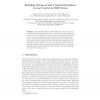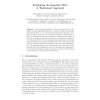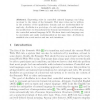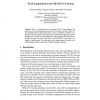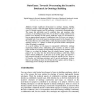SEMWEB
2007
Springer
14 years 5 months ago
2007
Springer
Semantic Web databases allow efficient storage and access to RDF statements. Applications are able to use expressive query languages in order to retrieve relevant metadata to perfo...
SEMWEB
2007
Springer
14 years 5 months ago
2007
Springer
For the development of Semantic Web technology, researchers and developers in the Semantic Web community need to focus on the areas in which human reasoning is particularly difficu...
SEMWEB
2007
Springer
14 years 5 months ago
2007
Springer
The increased availability of online knowledge has led to the design of several algorithms that solve a variety of tasks by harvesting the Semantic Web, i.e., by dynamically select...
SEMWEB
2007
Springer
14 years 5 months ago
2007
Springer
Developers of Semantic Web applications face a challenge with respect to the decentralised publication model: where to find statements about encountered resources. The “linked d...
SAMT
2007
Springer
14 years 5 months ago
2007
Springer
Abstract. This paper presents an approach to semi-automate photo annotation. Instead of using content-recognition techniques this approach leverages context information available a...
SAMT
2007
Springer
14 years 5 months ago
2007
Springer
Abstract. Multimodal and dialogue-based mobile interfaces to the Semantic Web offer access to complex knowledge and information structures. We explore more fine-grained co-ordina...
RR
2007
Springer
14 years 5 months ago
2007
Springer
Expressing rules in controlled natural language can bring us closer to the vision of the Semantic Web since rules can be written in the notation of the application domain and are u...
RR
2007
Springer
14 years 5 months ago
2007
Springer
Trust is a vital feature for the Semantic Web: If users (humans and agents) are to use and integrate system answers, they must trust them. Thus, systems should be able to explain t...
OTM
2007
Springer
14 years 5 months ago
2007
Springer
Despite significant advancement in ontology learning, building ontologies remains a task that highly depends on human intelligence, both as a source of domain expertise and for pro...
OTM
2007
Springer
14 years 5 months ago
2007
Springer
Abstract. We discuss our DLDB knowledge base system and evaluate its capability in processing a very large set of real-world Semantic Web data. Using DLDB, we have constructed the ...
